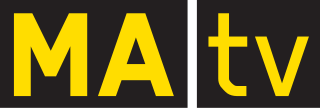Related Research Articles
Present-day telecommunications in Canada include telephone, radio, television, and internet usage. In the past, telecommunications included telegraphy available through Canadian Pacific and Canadian National.
The media of Canada is highly autonomous, uncensored, diverse, and very regionalized. Canada has a well-developed media sector, but its cultural output—particularly in English films, television shows, and magazines—is often overshadowed by imports from the United States. As a result, the preservation of a distinctly Canadian culture is supported by federal government programs, laws, and institutions such as the Canadian Broadcasting Corporation (CBC), the National Film Board of Canada (NFB), and the Canadian Radio-television and Telecommunications Commission (CRTC).

Persona Communications, formerly Regional Cablesystems, was a cable television, Internet and telecommunications provider in Canada.
Vidéotron is a Canadian integrated telecommunications company active in cable television, interactive multimedia development, video on demand, cable telephony, wireless communication and Internet access services. Owned by Quebecor, it primarily serves Quebec and Ottawa, as well as the Francophone communities of New Brunswick and some parts of Eastern Ontario. Its principal competitors are Bell Canada and Telus Communications.
Simultaneous substitution is a practice mandated by the Canadian Radio-television and Telecommunications Commission (CRTC) requiring broadcast distribution undertakings (BDUs) in Canada to distribute the signal of a local or regional over-the-air station in place of the signal of a foreign or non-local television station, when the two stations are broadcasting identical programming simultaneously.

Shaw Communications Inc. was a Canadian telecommunications company which provided telephone, Internet, television, and mobile services. The company was founded in 1966 as Capital Cable Television Company, Ltd. by JR Shaw in Edmonton. The company was acquired by and amalgamated into Rogers Communications in 2023; most operations were rebranded to the Rogers brand beginning in July of that year.
CJBN-TV, VHF analogue channel 13, was a Global-affiliated television station licensed to Kenora, Ontario, Canada. The station was owned by Shaw Communications under its cable systems unit, and was not part of the Shaw Media unit which was sold to Corus Entertainment in 2016. CJBN's studios were based alongside Shaw's local offices on 10th and Front Streets in Keewatin, and its transmitter was located near Norman Dam Road in Kenora. The station was carried on Shaw Cable channel 12, Bell Satellite TV channel 224 and Shaw Direct channel 320.
Television in Canada officially began with the sign-on of the nation's first television stations in Montreal and Toronto in 1952. As with most media in Canada, the television industry, and the television programming available in that country, are strongly influenced by media in the United States, perhaps to an extent not seen in any other major industrialized nation. As a result, the government institutes quotas for "Canadian content". Nonetheless, new content is often aimed at a broader North American audience, although the similarities may be less pronounced in the predominantly French-language province of Quebec.

Wild TV is a Canadian English language Category B specialty channel broadcasting programming focusing on hunting, fishing, shooting, and the outdoors. The channel is owned by Dieter Kohler through Wild TV Inc.
Rogers TV is a group of English-language community channels owned by Rogers Communications. Many of these channels share common programs. Rogers TV broadcasts in the Canadian provinces of New Brunswick, Newfoundland and Labrador and Ontario. Rogers TV is available only in communities served by Rogers' cable and telecom division, and is not carried by other television service providers. Its French counterpart is TV Rogers.

Shaw Spotlight was the name of locally based community channel services operated by cable TV provider Shaw Communications. The channels are available only to Shaw Cable subscribers and are produced in communities throughout western Canada.
Canada is served by various multichannel television services, including cable television systems, two direct-broadcast satellite providers, and various other wireline IPTV and wireless MMDS video providers.
YourTV is the brand of community channels owned by Cogeco. YourTV broadcasts into the Canadian provinces of Ontario and Quebec. Some channels broadcast in both the English and French languages, often on separate channels, in which case the French-language station is branded NousTV.
CTV 2 Alberta is a Canadian English language entertainment and former educational television channel in the province of Alberta. Owned by the Bell Media subsidiary of BCE Inc., it operates as a de facto owned-and-operated station of its secondary CTV 2 television system.
Digital terrestrial television in Canada is transmitted using the ATSC standard. Because Canada and the U.S. use the same standard and frequencies for channels, people near the Canada–United States border can watch digital television programming from television stations in either country where available. The ATSC standards are also used in Mexico, the Dominican Republic, Suriname, and South Korea.

MAtv is a Canadian community channels operated by the cable provider Vidéotron within the province of Quebec.
In 2007, significant ownership changes occurred in Canada's broadcast television industry, involving nearly every private English-language network and television system. In addition to the shuffling of network affiliations and mergers involving various networks, several new television stations and rebroadcast transmitters also signed on the air.
Fee-for-carriage, value-for-signal, negotiation for value, or the "TV tax" all refer to a proposed Canadian television regulatory policy which would require cable and satellite television companies to compensate conventional, over-the-air television stations for the right to carry their local signals. Such a system has long existed in the United States, under the name of retransmission consent.

CFHD-DT is an independent multicultural television station in Montreal, Quebec, Canada, owned by Sam Norouzi and his family. The station's studios are located on Christophe Colomb Avenue in Montreal's Ahuntsic district, at the home of the family's production company Mi-Cam Communications. Its transmitter is located at Mount Royal Park, near Downtown Montreal.

WWE Network is a Canadian English language discretionary specialty channel programmed by WWE and distributed by Rogers Sports & Media. Its programming consists entirely of the linear feed offered as part of the WWE Network video streaming service.
References
- ↑ para11, Review of community television policy framework, Broadcasting Notice of Consultation CRTC 2009-661, http://www.crtc.gc.ca/eng/archive/2009/2009-661.htm
- ↑ "Broadcasting Regulatory Policy CRTC 2016-224". CRTC. Retrieved 3 May 2017.
- ↑ "Shaw TV stations to close in Vancouver, Calgary and Edmonton as funds diverted to Global". CBC News. Retrieved 3 May 2017.
- ↑ "Update: Rogers TV Peel has closed". mississauga.com. Retrieved 3 May 2017.
- ↑ "Rogers TV Durham stays on-air but staff cut as Rogers reduces community TV support". DurhamRegion.com. Retrieved 3 May 2017.
- ↑ "CRTC says Vidéotron's community TV channel has failed in its mandate, but can become bilingual". Montreal Gazette. Retrieved 2020-09-02.
- ↑ Government of Canada, Canadian Radio-television and Telecommunications Commission (CRTC) (2015-02-04). "ARCHIVED - Complaint by Independent Community TV against Videotron G.P. and its community channel MAtv". crtc.gc.ca. Retrieved 2020-09-02.